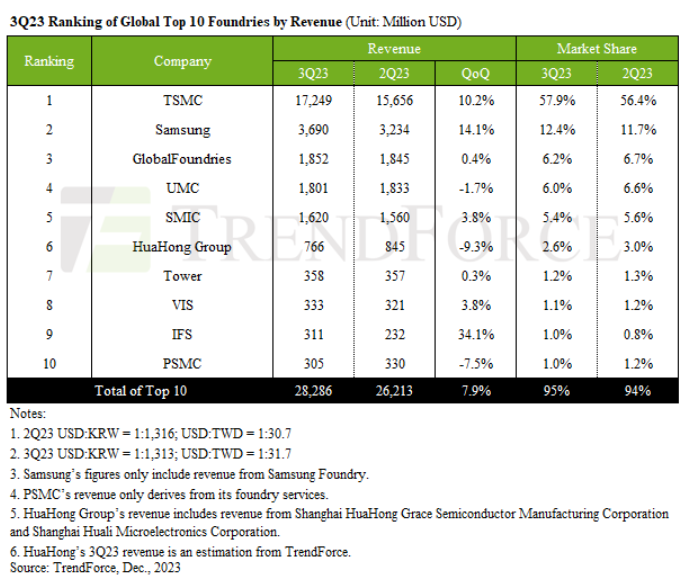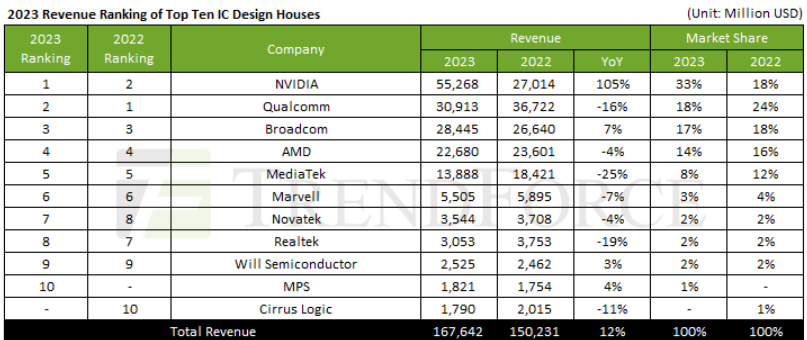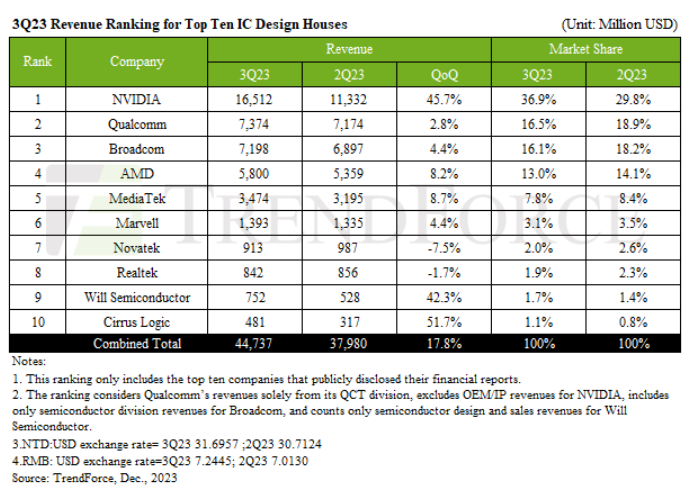- Ameya360 Component Supply Platform >
- Trade news >
- Top 10 Foundries Experience 7.9% QoQ Growth in 3Q23, with a Continued Upward Trend Predicted for Q4, Says TrendForce
Top 10 Foundries Experience 7.9% QoQ Growth in 3Q23, with a Continued Upward Trend Predicted for Q4, Says TrendForce
TrendForce’s research indicates a dynamic third quarter for the global foundry industry, marked by an uptick in urgent orders for smartphone and notebook components. This surge was fueled by healthy inventory levels and the release of new iPhone and Android devices in 2H23. Despite persisting inflation risks and market uncertainties, these orders were predominantly executed as rush orders. Additionally, TSMC and Samsung’s high-cost 3nm manufacturing process had a positive impact on revenues, driving the 3Q23 value of the top ten global foundries to approximately US$28.29 billion—a 7.9% QoQ increase.
Looking ahead to 4Q23, the anticipation of year-end festive demand is expected to sustain the inflow of urgent orders for smartphones and laptops, particularly for smartphone components. Although the end-user market is yet to fully recover, pre-sales season stockpiling for Chinese Android smartphones appears to be slightly better than expected, with demand for mid-to-low range 5G and 4G phone APs and continued interest in new iPhone models. This scenario suggests a continued upward trend for the top ten global foundries in Q4, potentially exceeding the growth rate seen in Q3.
TSMC’s 3nm process contributes substantially to revenue as it claims 58% market share in Q3
TSMC’s revenue grew by 10.2%—reaching US$17.25 billion—supported by strong demand in the PC sector and for smartphone components, including new iPhones and Android devices, as well as urgent orders for restocking mid-to-low end 5G and 4G inventories. The 3nm process alone contributed 6% to TSMC’s Q3 revenue, with advanced processes (≤7nm) accounting for nearly 60% of its total revenue.
Samsung Foundry also experienced robust growth, with its revenue reaching US$3.69 billion in Q3, a 14.1% QoQ increase. This was driven by orders for Qualcomm’s mid-to-low range 5G AP SoC, 5G modems, and mature 28 nm OLED DDI processes.
GlobalFoundries maintained a stable performance in Q3, with its revenue approximating US$1.85 billion, similar to the previous quarter. The company's revenue was predominantly supported by the home and industrial Internet of Things (IoT) sectors, which accounted for approximately 20% of its total revenue. Furthermore, a significant portion of this revenue boost was due to orders from the US aerospace and defense sectors.
UMC benefited from the support of urgent orders, which largely offset adjustments in automotive orders. Despite a slight decline in overall wafer shipments, UMC’s revenue experienced a minor quarterly decrease of 1.7%, amounting to approximately US$1.8 billion. Notably, the revenue from its 28/22 nm products saw a near 10% increase, representing 32% of UMC’s total revenue.
SMIC benefited from seasonal consumer product demands, especially urgent smartphone-related orders, leading to a 3.8% revenue increase fo US$1.62 billion in Q3. However, due to the diversification of the supply chain and the relocation of American customers outside China, the revenue share from American clients decreased to 12.9%. Conversely, revenue from Chinese clients increased to 84% due to the government’s localization initiatives and urgent orders for smartphone components.
IFS makes debut in rankings with highest revenue growth in Q3
Notable changes in the rankings from sixth to tenth position include VIS and IFS, with the latter entering the global top for the first time since Intel’s financial restructuring. VIS’ Q3 revenue increased by 3.8% to US$333 million—surpassing PSMC to take the eighth position—thanks to a recovery in LDDI and panel-related PMIC orders and prebuilt wafer shipments. IFS benefited from seasonal laptop orders in 2H23 and contributions from its advanced high-priced processes, recording a 34.1% increase in revenue to approximately US$311 million.
Other companies like HuaHong Group saw a 9.3% decrease in Q3 revenue to about US$766 million. HHGrace maintained steady wafer shipment levels from the previous quarter, but a roughly 10% decrease in ASP led to a decline in revenue. Tower Semiconductor saw stable demand in the smartphone, automotive, and industrial sectors, maintaining revenue at around US$358 million in Q3. PSMC witnessed a 7.5% drop in revenue to US$305 million, with PMIC and Power Discrete revenues declining nearly 10% and 20%, respectively, impacting overall performance.

Online messageinquiry

Unveiling the Intricacies of IC Design
- Week of hot material
- Material in short supply seckilling
| model | brand | Quote |
|---|---|---|
| CDZVT2R20B | ROHM Semiconductor | |
| RB751G-40T2R | ROHM Semiconductor | |
| MC33074DR2G | onsemi | |
| BD71847AMWV-E2 | ROHM Semiconductor | |
| TL431ACLPR | Texas Instruments |
| model | brand | To snap up |
|---|---|---|
| BP3621 | ROHM Semiconductor | |
| TPS63050YFFR | Texas Instruments | |
| STM32F429IGT6 | STMicroelectronics | |
| BU33JA2MNVX-CTL | ROHM Semiconductor | |
| ESR03EZPJ151 | ROHM Semiconductor | |
| IPZ40N04S5L4R8ATMA1 | Infineon Technologies |
- Week of ranking
- Month ranking
Qr code of ameya360 official account
Identify TWO-DIMENSIONAL code, you can pay attention to


Please enter the verification code in the image below:

























